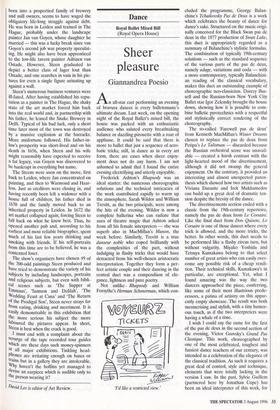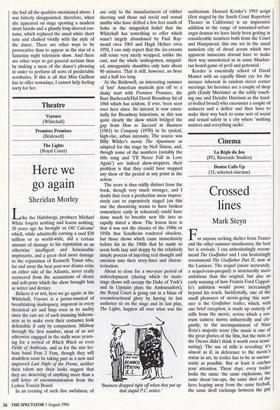Dance
Royal Ballet Mixed Bill (Royal Opera House)
Sheer pleasure
Giannandrea Poesio
An all-star cast performing an evening of bravura dances is every balletomane's ultimate dream. Last week, on the opening night of the Royal Ballet's mixed bill, the house was packed with an enthusiastic audience who saluted every breathtaking balance or dazzling pirouette with a roar of applause. It could be said that there is more to ballet that just a sequence of acro- batic tricks; still, in dance as in every art form, there are cases when sheer enjoy- ment does not do any harm. I am not ashamed to admit that I found the entire evening electrifying and utterly enjoyable. Frederick Ashton's Rhapsody was an ideal starter: the numerous choreographic solutions and the technical intricacies of the work contributed rapidly to warm up the atmosphere. Sarah Wildor and William Trevitt, as the two principals, were among the hits of the evening. Wildor is now a complete ballerina who can radiate that aura of theatre magic that Ashton asked from all his female interpreters — she was superb also in MacMillan's Manon, the week before. Similarly, Trevitt is a true danseur noble who coped brilliantly with the complexities of the part, without indulging in flashy tricks that would have detracted from his well-chosen aristocratic interpretation, Together they form a per- fect artistic couple and their dancing in the central duet was a compendium of ele- gance, lightness and pure poetry.
Not unlike - Rhapsody and William Forsythe's Herman Schmerman, which con- `I'd like a restricted view.' eluded the programme, George Balan- chine's Tchaikovsky Pas de Deux is a work which celebrates the beauty of dance for dance's sake. Structured on the music origi- nally conceived for the Black Swan pas de deux in the 1877 production of Swan Lake, this duet is appropriately regarded as a summary of Balanchine's stylistic formulas. The combination of typically 19th-century solutions — such as the standard sequence of the various parts of the pas de deux, namely adage, variations and coda — with a more contemporary, typically Balanchini- an reading of the classical vocabulary, makes this duet an outstanding example of choreographic neo-classicism. Darcey Bus- sell and the Russian-born NeW York City Ballet star Igor Zelensky brought the house down, showing how it is possible to com- bine balletic pyrotechnics with a respectful and stylistically correct rendering of the choreography.
The so-called 'Farewell pas de deux' from Kenneth MacMillan's Winter Dreams chosen to replace the pas de deux from Petipa's Le Talisman — discarded because the Russian orchestral score was unavail- able — created a harsh contrast with the light-hearted mood of the divertissement, although it did not swamp the general enjoyment. On the contrary, it provided an interesting and almost unexpected paren- thesis which showed how two artists such as Viviana Durante and Irek Mukhamedov can build up a great deal of dramatic ten- sion despite the brevity of the dance.
The divertissements section ended with a classic from the 19th-century repertoire, namely the pas de deux from Le Corsaire. Like the final duet from Don Quixote, Le Corsaire is one of those dances where every trick is allowed, and the more tricks, the better. In other words, this duet needs to be performed like' a flashy circus turn, but without vulgarity. Miyako Yoshida and Tetsuya Kumakawa belong to that select number of great artists who can easily over- come any possible risk of a cheap rendi- tion. Their technical skills, Kumakawa's in particular, are exceptional. Yet, what I found amazing was the way the two dancers approached the piece, conferring, like some of their most illustrious prede- cessors, a patina of artistry on this appar- ently empty showcase. The result was both mesmerising and stylish, with a tiny humor- ous touch, as if the two interpreters were having a whale of a time.
I wish I could say the same for the first of the pas de deux in the second section of the evening, Victor Gsovsky's Grand Pas Classique. This work, choreographed by one of the most celebrated, toughest and fussiest dance teachers of our century, was intended as a celebration of the elegance of the classical tradition. As such it requires a great deal of control, style and- technique, elements that were totally lacking in the version I saw. In the past, Sylvie Guillem (partnered here by Jonathan Cope) has been an ideal interpreter of this work, for
she had all the qualities mentioned above. I was bitterly disappointed, therefore, when she appeared on stage sporting a modern short hairdo and a ghastly long-sleeved cos- tume, which replaced the usual white short tutu and clashed vividly with the style of the dance. There are other ways to be provocative than to appear as the star of a Saturday night television show. And there are other ways to get general acclaim than by making a mess of the dance's phrasing in order to perform all sorts of predictable acrobatics. If this is all that Miss Guillem has to offer nowadays, I cannot help feeling sorry for her.



















































 Previous page
Previous page